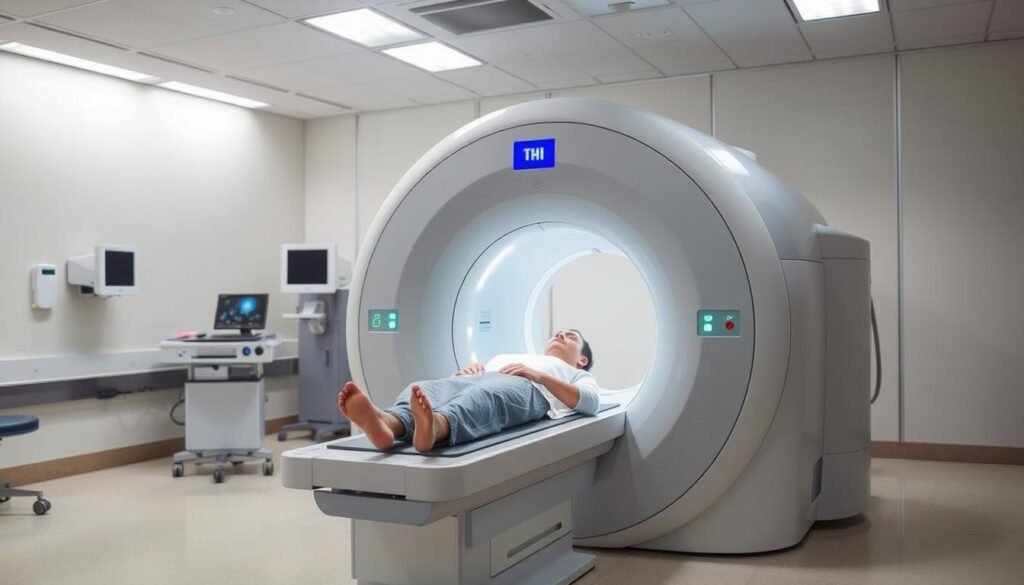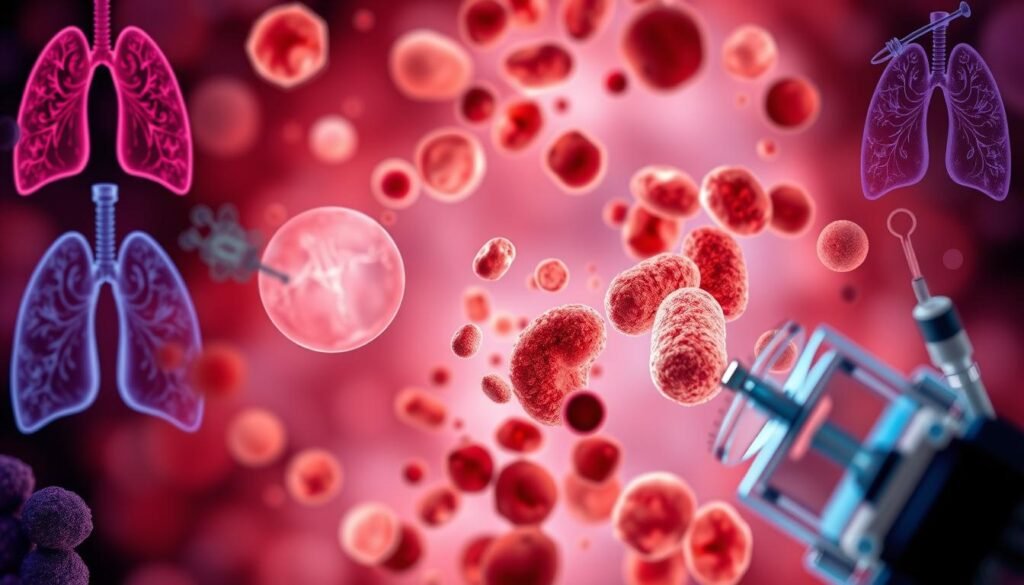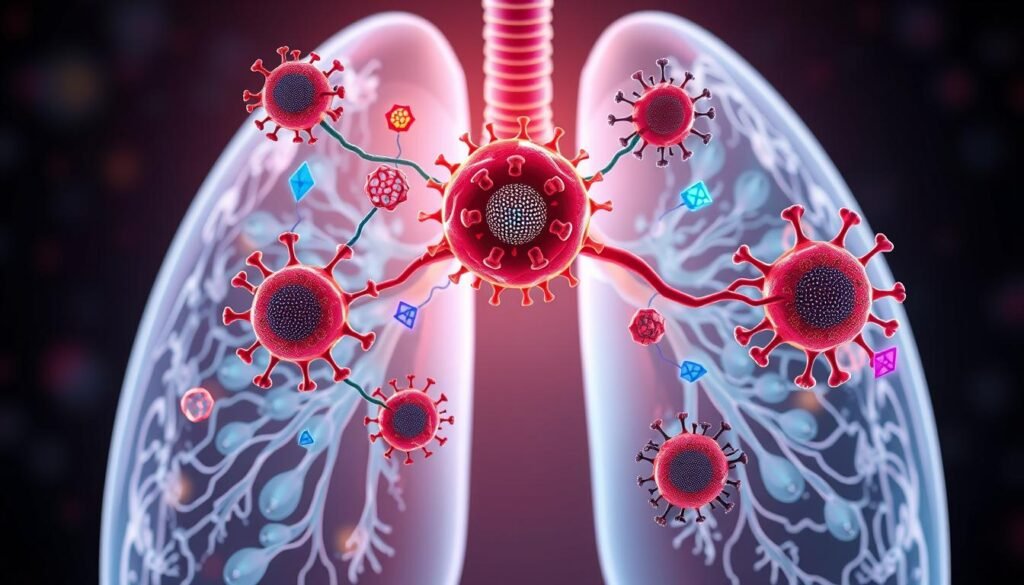Lung cancer takes more lives in the U.S. than breast, prostate, and colorectal cancers combined. It’s the top cause of cancer deaths. That’s why early detection of lung cancer is key, especially for those at high risk. Knowing the tests for lung cancer is vital if you smoke or used to. Finding it early can make a big difference in treatment success and life expectancy.
The top screening for lung cancer now is the low-dose computed tomography (LDCT) scan. If you’re 50 to 80 and smoked a lot (20 pack-years), yearly screenings are advised. To clarify, a pack-year means smoking a pack a day for a year. These facts stress the importance of knowing risks and taking action for your health.
This guide talks about tests and new steps in lung cancer screening. Our goal is to help you know your options and make smart health choices.
Key Takeaways
- Lung cancer is the most common cause of cancer deaths in the U.S.
- Annual screening with LDCT is recommended for high-risk individuals.
- Smokers and former smokers are at the highest risk for lung cancer.
- Early diagnosis can significantly improve treatment success and survival.
- Screening may present some risks, but benefits generally outweigh them.
- Insurance plans typically cover recommended lung cancer screenings.
Understanding Lung Cancer and Its Impact
Lung cancer is a top health issue, marked by startling lung cancer statistics. It’s the third most common cancer in the U.S., after breast and prostate cancers. About 235,000 new cases are found each year. Although over 90% of early-stage lung cancer patients survive, many are diagnosed late. This makes treatment more complex. Knowing these facts shows how serious lung cancer is.
Statistics on Lung Cancer Prevalence
Nearly 611,000 people in the U.S. are living with lung cancer today. Smoking is linked to about 90% of these cases. Even 60% of patients used to smoke, showing that quitting doesn’t instantly remove the risk. It points out the long-term risk for ex-smokers.
Risk Factors and Vulnerability
The main lung cancer risk factors are smoking, secondhand smoke, family history, and certain toxins. Radon and asbestos are dangerous toxins. People with lung cancer in their family or exposed to these toxins are at a higher risk. So, it’s crucial to get regular check-ups and know these risks for earlier detection.
For more info on screenings and diagnosis, the American Cancer Society has great resources. Being informed about the risks helps you manage your health better.
The Importance of Early Detection of Lung Cancer
Finding lung cancer early is key to better health outcomes and longer life. Knowing the pros of catching it early can push people at risk to get tested. Early action drastically changes a patient’s fight against cancer, emphasizing why those at risk must stay informed and get regular exams.
Benefits of Early Diagnosis
Spotting lung cancer early greatly improves how well treatments work and survival chances. If lung cancer is found when it’s still just in one area, the chances of living for at least five more years are much higher than if it’s found later. The main perks of catching it early include:
- Higher chances of beating the disease.
- More treatment options, like surgery, which might not work later.
- Better life quality with gentler treatments.
- Knowing more about lung cancer symptoms leads to smarter health choices.
For those at high risk, yearly scans can spot lung cancer early. People between 50 to 80 who’ve smoked a lot benefit from these scans. They’re a key way to stop the cancer from getting worse.
Potential Outcomes of Delayed Detection
If finding lung cancer is delayed, the consequences are serious. The cancer may limit treatment options and lower the chance of survival. Some severe effects include:
- A bigger chance of discovering the cancer late, when cure is tough.
- Treatments that may be harder and less effective.
- A higher risk of dying from the cancer.
- More stress for patients and their families due to harder treatments.
Knowing how bad it can get if lung cancer is found late shows why screening is crucial. People who might get lung cancer should talk to doctors about symptoms and prevention.
| Stage | 5-Year Survival Rate | Diagnosis Timing | Treatment Options |
|---|---|---|---|
| Stage I | ~80% | Early Detection | Surgery, Radiation |
| Stage II | ~60% | Moderate Detection | Surgery, Chemotherapy |
| Stage III | ~40% | Late Diagnosis | Chemotherapy, Radiation |
| Stage IV | ~5% | Advanced Detection | Palliative Care |
This table shows how early finding lung cancer can change survival rates. It proves that early detection truly saves lives.
Screening Options for Lung Cancer
Making the right health choices is vital, especially with lung cancer screenings. Guidelines help find those at more risk and ensure they get the right screenings. Following these can greatly improve the chances for people with lung cancer.
Recommended Screening Guidelines
The U.S. Preventive Services Task Force and the American Cancer Society have guidelines for lung cancer screenings. They suggest yearly CT scans for those 50 to 80 with a heavy smoking history. This is for people who smoked a lot over 20 years, and those who quit within the last 15 years.
- Individuals aged 50 to 80 years with a smoking history of at least 20 pack-years.
- Current smokers, or those who quit in the last 15 years.
- Not advised for those with serious health conditions or poor lung function.
- Annual screenings until it is unlikely to yield benefits.
Who Should Get Screened?
Figuring out who should get screened is key to using resources well. Screening focuses on high-risk groups, mainly based on smoking history. The risk from radiation in a low-dose CT scan is minimal. It’s about half of what we get from natural sources each year.
Screenings can also find other serious health issues like emphysema or heart problems. Studies show about half of the people screened will have nodules found. Growing nodules need watching or more tests.
| Criteria | Recommendations |
|---|---|
| Age | 50 to 80 years |
| Smoking History | 20 pack-years or longer |
| Quit Smoking | Within the last 15 years |
| Health Conditions | No serious lung issues |
| Annual Screening | Recommended if still benefitting |
Knowing about lung cancer screening guidelines helps people talk to their doctors. This leads to early detection and can save lives.
Tests for Lung Cancer
Finding lung cancer early is key to better treatment success. There are many tests for this. They help people know their options for checking lung cancer. The low-dose CT scan is really important for finding lung cancer early.
Different Types of Diagnostic Tests
There are different tests to find lung cancer. Some common ones include:
- Chest X-ray: It’s the first test and spots big issues. Yet, it may miss small tumors.
- Low-Dose CT Scan for Lung Cancer: Gives clearer pictures. It’s really good at finding lung cancer early.
- CT Scan: Gives more details after a chest X-ray. Helps look more into the lungs.
- Bronchoscopy: Doctors can see inside the airways and might take a sample.
- Biopsy Methods: Depending on where the tumor is, different sampling methods like mediastinoscopy and needle biopsy are used.
Low-Dose CT Scan: A Primary Tool
The low-dose CT scan is a top choice for checking lung cancer. It’s for people over 50 who smoked a lot. It can see smaller cancers that other tests might miss. People tested with it have a better chance of surviving lung cancer than those who only get a chest X-ray.
Unlike a chest X-ray, the low-dose CT scan is better at finding small tumors. It uses less radiation and is safer. Now, many clinics use this scan. It helps find cancer early in people who are at higher risk.

| Test Type | Description | Detection Capability |
|---|---|---|
| Certain Diagnostic Tests | Initial test to identify abnormalities | Less effective for early-stage detection |
| Low-Dose CT Scan | Advanced imaging with lower radiation | Highly effective for small tumors |
| CT Scan | Detailed imaging post-chest X-ray | High sensitivity but requires interpretation |
| Bronchoscopy | Direct visualization of airways | Effective for biopsy and assessments |
Knowing about the different lung cancer tests helps people make good health choices. The low-dose CT is a breakthrough in finding lung cancer early. It has greatly improved the chances for a better outcome for patients.
Low-Dose CT Scan for Lung Cancer Screening
The low-dose CT scan is a big step forward in fighting lung cancer. It’s especially for those who smoked a lot and are between 50 to 80 years old. This method uses less radiation but gives clear lung images. It’s key in catching lung cancer early.
How LDCT Works
A low-dose CT scan takes X-rays from different angles. Then, software creates detailed images of the lungs. This scan uses much less radiation than regular CT scans. So, it’s safer for checking lungs often.
What to Expect During a Low-Dose CT Scan
Getting a LDCT lung cancer scan is simple and fast. You need to wear comfy clothes and take off any metal like jewelry. The scan is very quick, taking just 10 to 30 seconds. You’ll lay on a moving table, but it won’t hurt.
After the scan, doctors will talk about the results and next steps. At first, false alarms can happen, but they become less common. People who smoked a lot should get scanned every year. The US Preventive Services Task Force advises this. It’s the best way to spot lung cancer early.
| Criteria | Details |
|---|---|
| Age | 50 to 80 years |
| Smoking History | 20 pack-year history or more |
| Smoking Status | Current smoker or quit within the past 15 years |
| Screening Frequency | Annual screenings recommended |
| Radiation Exposure | 1.4 mSv per scan |
Sputum Cytology and Its Role
Sputum cytology is important in finding lung cancer. It checks mucus from the lungs for weird cells. It’s not always used to find cancer early. But, it gives useful info for some patients. When used with other tests, it helps doctors understand a patient’s health better.
Studies show sputum cytology’s average success in spotting lung cancer is about 65%. In one study, out of 39 patients, 11 had lung cancer confirmed. In total, 5226 tests found cancer cells in mucus. It’s really good at finding early lung cancers in people at high risk.

The method works better for some lung cancers than others. It’s more accurate for squamous cell carcinoma. The chance of false alarms is low. And it rarely misses cancer. But it does miss about 40% of malignant lesions. It spots 71% of tumors in the center of the lungs. It’s not so good at finding tumors on the edges.
To sum up, sputum cytology gives doctors important clues, especially for people at high risk. But, doctors should use it with other tests. New studies and tests could make sputum tests even better.
If you want to know more about sputum cytology and lung cancer, go here.
Bronchoscopy: A Closer Look
Bronchoscopy is vital for diagnosing and managing lung issues, especially lung cancer. It helps patients understand its role in finding problems in the lungs. During the procedure, a camera on a flexible tube is put into the airways. This lets doctors see the lungs and take samples for more tests.
Procedure Overview
The bronchoscopy usually takes about 30 to 60 minutes. Doctors may use medicine to numb the throat or nose, making it more comfortable. Here’s what happens during the procedure:
- The patient lies on their back, made as comfortable as possible.
- A numbing medicine is given to ease discomfort.
- The bronchoscope goes through the nose or mouth into the airways.
- Tools through the bronchoscope can take tissue for biopsy.
- The airways are checked thoroughly at the end.
After it’s done, watching for signs like a lingering cough, fever, or trouble breathing is crucial. Biopsy results come in a few days and are then discussed with the patient.
Situations When Bronchoscopy is Recommended
Knowing when to use bronchoscopy is key for early diagnosis. It’s recommended for:
- Those with a cough that doesn’t get better.
- Odd results from tests like chest X-rays.
- Signs of lung cancer such as chest pain or losing weight without trying.
- Infections that aren’t cured with usual treatments.
While bronchoscopy is great for diagnosing lung cancer, it carries some risks like bleeding, infection, and a collapsed lung. Choosing to go ahead with it requires thinking about the patient’s overall health.
Understanding Lung Cancer Biomarkers
Lung cancer biomarkers are key in diagnosing and treating lung cancer. They help doctors understand the cancer’s specifics, leading to better treatment plans. These indicators can show changes in DNA, like mutations or rearrangements. This gives crucial insights into the cancer’s nature.
It’s vital to identify these biomarkers for precision medicine. Tests look at protein levels and tumor DNA in blood. This offers a clearer view of the cancer’s behavior.
Experts like Justin F. Gainor, M.D., and Dr. Heather Wakelee highlight their importance in therapy. With many driver mutations found, tests are advised, especially for non-small cell lung cancer (NSCLC) cases. Targeted therapies can then focus specifically, reducing side effects and increasing effectiveness.
Defining Lung Cancer Biomarkers
Lung cancer biomarkers signify various cancer indicators. Examples include mutations and gene deletions. These help gauge the disease’s severity and how well treatments might work. For example, the PD-L1 protein’s level can guide immunotherapy choices, affecting treatment results significantly.
Potential Benefits of Biomarker Testing
Biomarker testing for lung cancer brings many benefits. It tailors treatments to the patient’s unique cancer. Advantages include:
- Targeted therapy options based on specific mutations
- Evaluating and fine-tuning treatment responses
- Helping doctors decide on the best care strategies
- Boosting patient outcomes and experiences
As research advances, it’s key to know the latest treatment options. Talking with healthcare providers about biomarker testing can ensure patients get the most tailored care.

Consultation and Shared Decision-Making
Talking with health experts is key during the lung cancer screening journey. Patients gain from talking about their unique risk factors, leading to better choices. Highlighting shared decision-making in healthcare creates a team effort. In this effort, patients and doctors work together to make a screening plan just for them.
Importance of Professional Guidance
Guidance from experts is crucial for those looking into lung cancer screening. One study found that patients correctly answered only about 41.4% of questions on lung cancer screening. This shows a big gap in understanding that can affect their choices. Out of those asked, 68.3% got info from their doctors about screening benefits.
However, only 20.8% were told about the possible risks. With 33.6% feeling unsure about their decision, it’s important for doctors to help clear things up. This means offering better information and support.
Insurance and Coverage for Screening Tests
Knowing about insurance coverage for lung cancer screening is crucial too. Many depend on plans like Medicare. Medicare often pays for scans for those at high risk. When talking to patients, it’s key to explain clearly what insurance covers. They should also learn about any costs they must pay themselves. The study showed that primary care doctors only had these talks half the time. This points out the need for better healthcare guidance throughout the process.
| Factor | Statistic |
|---|---|
| Knowledge of Screening | 41.4% of questions answered correctly |
| Presentation of Benefits | 68.3% informed by providers |
| Information on Harms | 20.8% informed |
| Educational Materials Provided | 30.7% received materials |
| Decisional Conflict | 33.6% experienced conflict |
| Patient Involvement in Decision | 86.6% felt involved |
| Discussion on Smoking Cessation | 85.3% discussed |
Conclusion
Lung cancer is a huge health issue in the U.S., with a diagnosis made every two minutes. More than 361 people lose their lives to this disease each day. It’s crucial to know the roles of different summary of lung cancer tests for early detection. By using low-dose computed tomography (LDCT), we can cut death rates by up to 20%.
The importance of lung cancer screening is clear from the rising survival rates. These rates have gone up 26% to 28.4% over five years. Yet, only 16% of people who should get screened actually do. This shows we need to teach more people about these tests. Getting more people screened could add 500,000 years to lives and save $500 million.
Early detection of lung cancer is super important. Educating people about screening options helps them make smart health choices. Knowing about these options can lead to better treatment results. For more info on lung cancer, check the National Lung Screening Trial and detailed disease explanations.